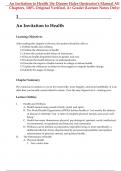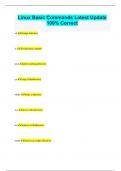An Invitation to Health 18e Dianne Hales (Instructor's Manual All
Chapters, 100% Original Verified, A+ Grade) (Lecture Notes Only)
1
An Invitation to Health
Learning Objectives
After reading this chapter in the text, the student should be able to:
1.1 Define health and wellness.
1.2 Outline the dimensions of health.
1.3 Assess the current health status of Americans.
1.4 Discuss health disparities based on gender and race.
1.5 Evaluate the health behaviors of undergraduates.
1.6 Describe the impact of habits formed in college on future health.
1.7 Explain the influences on behavior that support or impede healthy change.
1.8 Identify the stages of change.
Chapter Summary
We extend an invitation to you to live more fully, more happily, and more healthfully. It is an
offer that you literally cannot afford to refuse. Your life may depend on it—starting now.
Lecture Outline
I. Health and Wellness
A. Health means being sound in body, mind, and spirit.
B. The World Health Organization (WHO) defines health as “not merely the absence
of disease or infirmity” but “a state of complete physical, mental, and social well-
being.”
C. Health has many dimensions: physical, psychological, spiritual, social, intellectual,
environmental, occupational and financial, and community.
D. Wellness can be defined as purposeful, enjoyable living or, more specifically, a
deliberate lifestyle choice characterized by personal responsibility and optimal
enhancement of physical, mental, and spiritual health.
II. The Dimensions of Health
A. Physical Health
1. Not a static state
© 2019 Cengage Learning. All Rights Reserved. May not be scanned, copied or duplicated, or posted to a
publicly accessible website, in whole or in part.
,Instructor’s Manual – An Invitation to Health, 18e
B. Psychological Health
1. Our emotional and mental states
C. Spiritual Health
1. Spiritually healthy individuals identify their own basic purpose in life; learn
how to experience love, joy, peace, and fulfillment; and help themselves and
others achieve their full potential.
D. Social Health
1. The ability to interact effectively with other people and the social environment,
to develop satisfying interpersonal relationships, and to fulfill social roles
E. Intellectual Health
1. The ability to think and learn from life experience, your openness to new ideas,
and your capacity to question and evaluate information
F. Environmental Health
1. The effect your world has on your well-being
G. Occupational and Financial Health
1. The balance between the rewards and challenges of a career and how these
affect your well-being
I. Community Health
1. The complex interrelationships between one person’s health and the health of
the community and environment
III. Health in America
A. The United States spends more than any other nation on health care.
1. Among the diseases taking the greatest toll on Americans’ well-being are
hypertension, heart disease, diabetes, arthritis, and autoimmune disorders.
2. Life expectancy in the United States has declined recently.
B. Healthy People 2020
1. Mission
2. Goals
C. Health Disparities
1. Why race matters
2. Cancer
3. Cardiovascular disease
4. Diabetes
5. Infant mortality
6. Mental health
7. Infectious disease
D. Sex, Gender, and Health
1. Sex is a classification according to the reproductive organs and functions that
derive from the chromosomal complement.
© 2019 Cengage Learning. All Rights Reserved. May not be scanned, copied or duplicated, or posted to a
publicly accessible website, in whole or in part.
,Instructor’s Manual – An Invitation to Health, 18e
2. Gender is a person’s self-representation as male or female or how social
institutions respond to a person based on the individual’s gender presentation.
IV. Health on Campus
A. College and Health
1. Health risks increase significantly
B. How Healthy Are Today’s Students?
1. About 37 percent of undergraduates have overweight or obese BMI.
2. 47 percent of undergraduates get recommended amounts of physical activity.
3. About half of those engaging in vaginal intercourse report having used a
condom always or most of the time.
4. About 6 in 10 report drinking alcohol at least once in the previous month; more
than 3 in 10 report binge drinking within past 2 weeks.
5. About 9 percent smoked a cigarette at least once in past month; growing
number is trying e-cigarettes.
6. One in five used marijuana in past month.
7. Many use prescription stimulants, and some misuse prescription opioid drugs.
8. Only 12 percent gets enough sleep.
9. College athletes have lower health-related quality of life.
10. More than half were tested for HIV in past year; 4 in 10 sexually active students
have not been tested.
C. The Future Starts Now
1. First steps
2. Various interventions tried by colleges/universities to improve students’ health
choices and habits
D. Student Health Norms
1. Social norm refers to a behavior or an attitude a particular group expects, values,
and enforces.
E. The Promise of Prevention
1. No medical treatment can compare with the power of prevention.
F. Protecting Yourself
1. There is a great deal of overlap between prevention and protection.
2. Assess risk to determine protection.
G. Understanding Risky Behaviors
1. Young people overestimate immediate pleasure compared with the danger of
some risky behaviors.
V. Making Healthy Changes
A. Understanding Health Behavior
1. Predisposing factors
Enabling factors
2. Reinforcing factors
© 2019 Cengage Learning. All Rights Reserved. May not be scanned, copied or duplicated, or posted to a
publicly accessible website, in whole or in part.
, Instructor’s Manual – An Invitation to Health, 18e
VI. How People Change
A. Health Belief Model
B. Self-Determination Theory
C. Motivational Interviewing
D. Self-Affirmation Theory
E. Transtheoretical Model
1. Stages of change
2. Processes of change
3. Self-efficacy and locus of control
Discussion Questions
• Discuss with students which dimension of health is most prominent in their lives.
Why? With which are they least concerned? Ask students what they could do to
incorporate all components into their lives. What are some of the obvious differences
between those who do incorporate all (or many) of these aspects into their lives and
those who concentrate on only one or two components?
• Ask students to take a quick inventory of their own and their immediate family’s
health status. Using the statistics found in the text, compare their inventory with the
different health risks for their racial and ethnic groups. Ask students what factors they
believe contribute to the differences in health status that various racial and ethnic
groups face. How might religion affect the health of a culture?
• What challenges do ethnicity, race, religion, gender, and sexual orientation bring to
the health-care system? What actions can government, universities, hospitals, and
other health-care facilities and individuals take to address these differences? Identify
some of the religious differences that might affect the overall health of an individual
for better or worse. What factors in the health-care system might keep various
individuals from keeping up with their health?
• Ask students how they have handled their newfound freedom since attending college
or leaving home for the first time. How have their parents handled and reacted to it?
How does this sense of independence affect their health? What health challenges do
they face?
• Ask students to identify ways they can keep their medical costs down without
sacrificing good health. What options do they have if they are not insured?
© 2019 Cengage Learning. All Rights Reserved. May not be scanned, copied or duplicated, or posted to a
publicly accessible website, in whole or in part.





